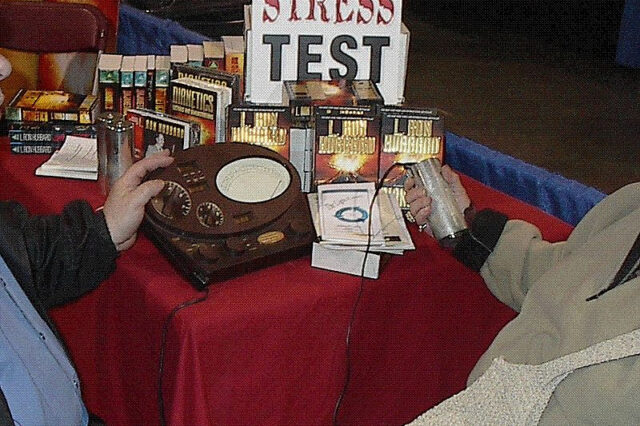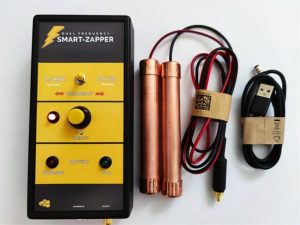10 Useless Health Gadgets That Somehow Sell Well
It sounds like you’re referencing a wellness device that claims to address various issues like “imbalanced frequencies” or “low cellular voltage.” These types of devices often market themselves as solutions for improving energy, balance, or overall wellness, even if someone isn’t experiencing any obvious symptoms.
Many wellness products on the market today are promoted with phrases like these, targeting everything from mental clarity to physical healing. However, it’s essential to approach these devices with critical thinking, especially when they promise to solve vague or undefined issues like “psychic aberrations” or “imbalanced frequencies.”
10. Spooky2 : The Controversial Return of Rife Technology
Have you ever wondered if all medical conditions could be linked to specific electromagnetic frequencies? If the answer is yes, you’ve likely come across the name Rife machine. Invented in the 1920s by the innovative Royal Raymond Rife, this device was designed to send electromagnetic pulses aimed at curing almost any disease. Unfortunately for Rife, his groundbreaking ideas were met with skepticism and hostility from the mainstream scientific community. By the time of his death, he had fallen into obscurity, his legacy tarnished by both scandal and a lack of acceptance.
Fast forward to recent times, and Rife’s theories have experienced a remarkable resurgence, especially in the wake of the COVID-19 pandemic. One of the most prominent examples of this revival is the Spooky2 Scalar, which has been marketed as “the affordable Rife device for every home.” Promising to “protect you and your family from the virus,” the device boasts that its scalar energy provides “optimal energetic support for the immune system.” This bold claim, which ties into Rife’s original theories, has attracted both attention and controversy.
However, not everyone is convinced. The Federal Trade Commission (FTC) quickly intervened, issuing a warning against the device’s unproven medical claims. Despite this, the Spooky2 Scalar continues to thrive in the market, with its basic kit priced at $1,600. It comes packaged in a rugged briefcase, complete with a playful smiling ghost logo—a whimsical touch that may make skeptics raise an eyebrow.
As the debate over Rife technology continues, it’s clear that the line between science and speculation remains as blurry as ever. Whether you see Spooky2 Scalar as a revolutionary health tool or just another piece of questionable wellness tech, one thing is certain: the fascination with scalar energy and electromagnetic healing is far from fading.
9. The E-Meter: A Tool with a Controversial Past and a Questionable Present

When it comes to peculiar inventions, the E-meter—or as it was originally called, the Electropsychometer—stands out as a strange but fascinating piece of history. Despite what followers of Scientology might claim, this device wasn’t the brainchild of L. Ron Hubbard. In fact, it was created by Volney Mathison, a chiropractor, as a tool for psychotherapy and psychological analysis. Ironically, this invention later became central to Scientology’s practices, despite Hubbard’s well-known disdain for psychotherapists.
Mathison likely had no idea his device would be repurposed in such a controversial way. Hubbard, however, saw an opportunity. He used the E-meter to supposedly identify and “clear” individuals of serious mental or even criminal issues. This process, referred to within Scientology as detecting “discreditable reads,” essentially became a gateway for recruits. But here’s the kicker: the E-meter was never intended to do any of that.
Today, the Church of Scientology assembles its own version of the device at Gold Base, a highly secure compound in California that operates under constant armed guard. These devices are priced at a hefty $4,000 each, but if you’re curious (or skeptical), you can find less expensive alternatives. Non-affiliated Electropsychometers or even second-hand devices from ex-Scientologists (members of the so-called FreeZone) are sometimes available on online marketplaces like eBay.
At its core, the E-meter is little more than a rudimentary lie detector—or, if you prefer, a “polygraph lite.” It’s essentially a galvanometer paired with two tin can-like electrodes. Powered by leaky batteries, it measures the electrical resistance of your skin. While that might sound advanced, the science behind it is rudimentary at best.
Hubbard, however, had a more extravagant vision. He claimed—or perhaps more accurately, pretended—that the E-meter could do far more than measure skin resistance. He even went so far as to assert that it could cure illnesses. Of course, this claim attracted the attention of authorities, and the U.S. government took legal action against him. Even today, the Church of Scientology admits that the device itself is incapable of achieving anything on its own.
Despite its limitations, the E-meter has found a place in the hands of unscrupulous individuals. Whether used as a tool for manipulation or simply as a quirky relic of Scientology’s past, it’s a reminder of how technology—and the claims made about it—can be twisted to serve various agendas.
8. BioResonance Machines: Can They Really Heal Your Body with Sound Waves?
Are you feeling a little off? Perhaps it’s time to scan your internal organs for imbalanced frequencies and explore a non-invasive method to identify potential health issues. The idea behind BioResonance Machines is based on the fascinating notion that every cell, tissue, and organ in your body emits unique electromagnetic waves. These frequencies, according to proponents, shift in response to various stresses, and each disease supposedly has its own “signature resonance frequency.”
Imagine being able to detect these imbalances without needing invasive procedures. By simply attaching electrodes, you could potentially scan for a variety of conditions. Sounds too good to be true? Well, it’s a concept that first emerged from Russian scientists in the 1990s and has since been developed further by OBERON, a Florida-based company.
The pitch? The BioResonance Machine doesn’t just scan your organs for potential diseases—it also promises to heal them by adjusting the frequencies of damaged cells. The process allegedly uses headphones to “tune” your cells back to their optimal frequencies, all without any chemicals, side effects, or disruption to your daily life. It’s marketed as a home-friendly, non-invasive alternative to traditional medicine, designed to work alongside healthy nutrition and other treatments.
While this might sound like something out of science fiction, there is a real-world example worth considering. Rayonex Biomedical, another company in the field, claims to have clinical proof of the BioResonance Machine’s effectiveness for treating conditions like cervical spine syndrome (commonly known as neck pain). However, before getting too excited, it’s worth noting that the study was conducted by the company itself, and many critics argue that placebo effects might be at play. Despite these doubts, Rayonex has shown reluctance to conduct further trials for other conditions, with anecdotal evidence being the only support for their broader claims.
Whether you’re a skeptic or a believer in the potential of these machines, one thing is certain: the idea of using frequencies to heal the body is a captivating and ongoing experiment.
7. The Stimulations VII Vacuum Device: A Revolutionary Solution or a Legal Headache?

Feeling self-conscious about your bra size? For those looking to enhance their natural curves without resorting to surgery, the Stimulations VII vacuum device seemed like a game-changer. Marketed as a non-invasive way to permanently enlarge breast tissue, this device promised incredible results. Simply place the self-sealing dome over your bust, activate the pump, and—voilà!—you could achieve an enlargement of up to four cup sizes. Even more astonishingly, it claimed to regrow breasts lost due to mastectomy.
Sounds too good to be true? Well, it might just be. While the concept of the Stimulations VII is undeniably intriguing, its journey from innovative product to legal controversy is equally fascinating.
The device was developed by New Womyn, a company based in Iowa. However, its time in the spotlight was marred by a lawsuit that brought the company—and its CEO, Dan Kaiser—into the public eye. In the early 2000s, an unhappy customer took New Womyn to court over a refund dispute. The woman had purchased the Stimulations VII for $2,000 but was denied a refund when she wasn’t satisfied with the results.
Her frustration stemmed from the fine print. The company’s “18-month money-back guarantee” came with a catch: to qualify for a refund, she had to use the device consistently for 18 months and visit a doctor once a month during that time. Understandably, she felt misled and took her complaint to court.
While the company’s terms might seem reasonable to some—after all, they did require consistent use and medical supervision—the customer’s dissatisfaction sparked a legal battle. In the end, Dan Kaiser, New Womyn’s CEO, was ordered to pay a $90,000 civil penalty.
The case raises an interesting question: How much responsibility should companies bear for setting clear expectations with their customers? On one hand, the terms of the guarantee were outlined in the fine print. On the other hand, the customer argued that these terms were not adequately communicated or were overly restrictive.
The Stimulations VII itself remains a curious footnote in the history of beauty and wellness technology. While it’s unclear whether the device is still available on the market today, its story serves as a reminder of the fine line between innovation and legal entanglement.
6. BioPhotonic Scanner: Measuring Your Skin’s Antioxidant Health
Ever wonder how many carotenoids are lurking in your skin? Or maybe you should—because these antioxidants, which give plants like carrots and tomatoes their vibrant hues, could hold the key to reducing your risk of disease. Carotenoids, such as beta-carotene, lutein, and lycopene, are widely believed to play an important role in improving health, particularly when you eat fruits and vegetables rich in these compounds.
Enter the BioPhotonic Scanner—a device that claims to measure the carotenoid levels in your skin. Why is this important? Because the level of carotenoids in your skin can offer insight into how well you’re nourishing your body. It’s especially helpful if you struggle with keeping a food diary, or if you’re simply curious about how much of those antioxidant-rich veggies you’ve been consuming. Think of it as a quick, no-fuss way to get a snapshot of your antioxidant intake.
Now, not everyone is convinced. Critics point out that the scanner only measures carotenoid levels in the skin, and some argue that it doesn’t reflect your body’s overall antioxidant status. But—while it’s true that there’s a lack of definitive scientific proof backing the device—what if this little gadget actually works? What if, just by knowing your carotenoid levels, you could optimize your diet and health? Could you really afford to pass up such a chance?
But wait, there’s more. If your scan shows that your carotenoid levels aren’t up to par, the company that sold you the scanner has the perfect solution: antioxidant supplements to boost your levels. It’s the ultimate in convenience—measure, adjust, and improve, all in one neat little package.
5. The BioCharger: A High-Tech Energy Boost or Just a Glowing Gimmick?
Ever feel like you’re running low on “subtle energy”? If so, the BioCharger might seem like the answer. Invented by Jim Girard, this sleek device promises to deliver pulsed harmonics at customizable frequencies, targeting weakly vibrating cells to re-energize and revitalize your natural magnetic energy. It claims to align your mind and body, boost your cellular voltage, and even help you feel more connected to the world around you. Sounds impressive, right?
But here’s the catch: you could achieve similar results by simply walking barefoot on grass, releasing negative emotions, listening to soothing sounds, or sipping alkaline water. The difference? Those activities are free. The BioCharger, on the other hand, will set you back a cool $15,000.
According to the creators of the BioCharger, “over 90% of our day is spent indoors, blocked from nature’s vital energies.” Their solution? Skip the fresh air and sunlight and invest in this high-tech machine instead. After all, who needs nature when you can have a glowing plasma gas spectrum tube in your living room?
Of course, the BioCharger doesn’t come with much scientific backing. But don’t worry—if you’re skeptical, there are plenty of testimonials to convince you otherwise. And if those aren’t enough, there’s a 45-day guarantee. Of course, you’ll still have to pay the non-refundable $250 shipping fee, but hey, no risk, right?
The BioCharger’s design certainly adds to its appeal. With its menacing red glow and futuristic aesthetic, it looks like something straight out of a sci-fi movie. Who needs evidence when your device looks this cool? You could even use it as a conversation starter at parties—or better yet, charge your friends for “treatments” and make your money back.
Speaking of which, Michael Nguyen, a self-proclaimed fecal transplant enthusiast and one of the BioCharger’s most high-profile advocates, admits that the device is essentially a glorified placebo. He compares its effectiveness to journaling—hardly groundbreaking. Yet, he still uses it regularly. And if it works for him, maybe it’s worth a shot, right?
4. Electro Physiological Feedback Xrroid: The Controversial Quantum Biofeedback Device
Back in 2005, an Oklahoma woman, seeking relief from joint and leg pain, turned to the EPFX quantum biofeedback device for help. Despite the device’s connection to her husband’s tragic death—he had used it while battling cancer—the woman remained hopeful that it would restore her health. She believed the worst part of his illness wasn’t the cancer, but the side effects of the hospital treatments. Tragically, she passed away the same year, but the device’s supporters claim it still works wonders for many others.
The EPFX’s promoters offer only glowing praise for it. Even its inventor, the self-proclaimed genius William Nelson, who claims to have helped NASA save Apollo 13 as a teenager, argues that the device can cure everything from cancer to AIDS. Nelson, who reportedly has eight doctorates (though the legitimacy of these credentials is unclear), made his fortune by selling more than 17,000 devices at $20,000 each. With his wealth, he resides in a mansion in Budapest, where he spends his time making movies about the FDA’s alleged villainy and holding motivational talks for sales teams.
But beyond the hype, what does the EPFX actually claim to do? According to its enthusiasts, this device targets the root causes of illness, not just masking symptoms. It offers real-time feedback, with a display that supposedly shows healing as it happens. For example, it can depict arterial blockages as little white blobs, which allegedly shrink and disappear as treatment progresses. Similar to other biofeedback devices like the BioResonance Machine, the EPFX works by detecting electrical imbalances—things like voltage, amperage, and electron pressure—and then attempting to correct them.
Whether it’s a true medical breakthrough or a high-tech placebo is up for debate, but the EPFX certainly has its share of believers—and critics. As with many alternative therapies, the jury is still out on whether the device offers real, scientifically-proven results.
3. Zapper: The No-Nonsense Wellness Device

Forget the jargon-filled names; the Zapper cuts through the noise with its straightforward, no-nonsense approach to wellness. Created by Hulda Clark, a self-styled doctor of physiology (although her doctorate was actually in zoology), the Zapper is marketed as a tool that can eliminate parasites, bacteria, and viruses without damaging your body’s tissues. The concept is simple: the device delivers low-voltage electrical pulses through two handheld electrodes, zapping away harmful invaders.
Not impressed yet? For those looking to up the ante, there’s the Orgone Zapper. This model does everything the regular Zapper does but with a twist—it claims to harness orgone energy for additional healing benefits. But don’t get too carried away. There are warnings. If you have a pacemaker or are pregnant, it’s best to stay clear. The Zapper can’t differentiate between parasites and unborn babies, and it certainly won’t take it easy on you if you have a pacemaker.
Even if you’re not dealing with an infestation, some users swear by the Zapper for its “aura-enhancing” effects after just half an hour of use. While Clark suggested seven-minute sessions as the ideal length, modern Zapper enthusiasts tend to push the limits. Just be mindful of any burn marks—and remember, sweat can interfere with the process. If you begin seeing skin irritation, it’s time to stop!
You might be thinking: “Why not just hook myself up to a car battery?” Well, Hulda Clark’s Zapper isn’t as simple as that. It’s equipped with a positive offset square wave, which—unless you’re a specialist—probably means nothing to you. But it’s part of what sets the Zapper apart from any DIY electrical concoction.
2. The Ozone Generator: A Controversial Solution for Cleaner Air?
The thinning of Earth’s ozone layer is a well-documented environmental concern, with its harmful effects spanning global warming to increased UV radiation. It’s strange, then, how the same chemical compound that contributes to this atmospheric challenge—ozone—became a hot-selling “miracle” solution for everyday households. Enter the ozone generator, a device marketed as a powerful tool for eliminating household odors, killing pathogens, and purifying indoor air. Its pitch? If ozone depletion is bad for the planet, ozone generation must be good for your home. Logical? Debatable. Effective? Even more so. But here’s the catch: ozone may not be as harmless as the sales pitch implies.
The logic seems appealing at first glance. After all, ozone is a naturally occurring substance in the Earth’s upper atmosphere, where it shields us from harmful UV rays. By this reasoning, introducing ozone indoors might seem like a foolproof way to get rid of stubborn smells, germs, and other invisible threats. Proponents of ozone generators often emphasize their simplicity: just plug the machine into your wall socket, let it generate a high-voltage electrical field, and watch as it “transforms” stale, oxygen-rich air into fresh, crisp ozone.
But here’s where things get tricky. While ozone is undeniably effective at neutralizing certain odors and even some microorganisms like bacteria and viruses, it also comes with well-documented risks. Critics, including the Environmental Protection Agency (EPA), the American Lung Association, and even the Food and Drug Administration (FDA), have long flagged ozone as a potential health hazard when used indoors at high concentrations. Prolonged exposure to elevated ozone levels can irritate the lungs, worsen respiratory conditions like asthma, and even contribute to long-term health complications. Adding to the problem, ozone itself is not a selective cleaner—it doesn’t just target pollutants. Instead, it can react with other airborne chemicals, inadvertently generating harmful byproducts like formaldehyde or other volatile organic compounds (VOCs).
That said, the appeal of ozone generators persists. For one, they’re marketed as an “all-natural” air-purifying solution—after all, ozone occurs naturally in the atmosphere. Moreover, some people swear by their efficacy in tackling persistent household odors, whether from pets, cooking, or mildew. Still, experts caution restraint, arguing that the risks often outweigh the benefits. In fact, the EPA outright advises against using ozone generators in occupied spaces, suggesting that any perceived “cleaning” effect is far outweighed by the potential for respiratory harm.
Still, there’s something fascinating about these machines. They’re compact, relatively affordable, and promise a futuristic solution to an age-old problem—how to keep the air in your home clean and fresh. For some, the appeal of eradicating germs and odors without chemicals is simply too good to resist.
1. The Hyper Dimensional Resonator : A Gateway to Parallel Realities
The Hyper Dimensional Resonator is no ordinary wellness device. In fact, it doesn’t quite fit into the typical category of health gadgets. A radionic time travel machine, this curious invention is designed to aid in astral projection by emitting an endless stream of white chi energy. Developed in 1981 on a Nebraska farm, it’s an upgraded version of the original Sonic Resonator, boasting a major enhancement: a caduceus coil electromagnet. Intrigued yet? Let’s dive into how it works.
Operating the Hyper Dimensional Resonator is surprisingly simple: you just strap on the time-coil headband, spit in the witness well, add a quartz crystal, position the electromagnet between your legs, and adjust the dials to the date you wish to visit (both go up to 10). Then, enter a meditative state and gently rub the rubbing plate. If all goes according to plan, you’ll find yourself transported to your desired spacetime coordinates—astrally, of course. However, if you’re seated on a grid point or vortex, you might just end up physically in another dimension.
Users have reported some truly out of this world experiences. Common destinations include UFOs, foreign lands, and even parallel dimensions or timelines. Some users claim to have returned with objects, only to watch them disintegrate on arrival. In other cases, the shifts are subtler. One user, after what seemed like an unsuccessful session, woke up feeling “off,” as though in the wrong place. His confusion grew when he opened his fridge to find that the cookie dough he had stored was now missing. After calling his wife, he was shocked to learn that there had never been any cookie dough in the fridge to begin with. Another participant who used the machine with its inventor back in 1989 described a surreal experience: “When he turned it on, clouds appeared in the room, and sparks danced around the chandelier.” While it initially seemed uneventful, the user noticed a strange alteration while watching their favorite movie, Shane—dialogue that had once been memorized was now spoken by different characters. Needless to say, the experience was quite unsettling.
Despite the potentially spooky side effects, the Hyper Dimensional Resonator is ultimately marketed as a wellness device. Frequent use is said to support spiritual growth and expand one’s consciousness. However, there is one important caveat: under no circumstances should you get blood in the witness well. Doing so is believed to attract demons—and no one wants that.

























